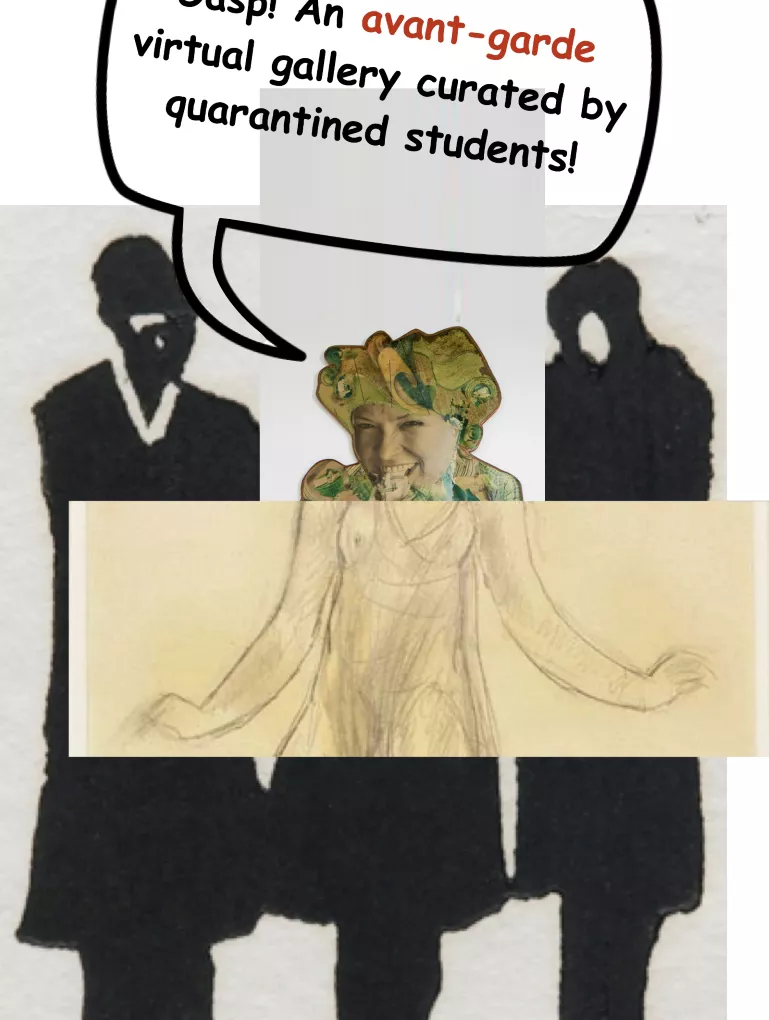
In the “manifesto of the course” for A Gendered History of the Avant-Garde: Bodies, Objects, Emotions, Ideas, Assistant Professor of Italian Alessandro Giammei describes it as “an experimental course about experimentalism, we reject total commitment: This manifesto will change when we need to update it.”
Perfect for the spring of 2020.
Prior to spring break, Giammei and his students had visited Special Collections and, with the help of Carrie Robbins, Bryn Mawr’s curator of art and artifacts, started the process of choosing material related to the avant-garde and neo-avant-garde to examine and eventually share with the rest of the College through some sort of gallery, small conference, posters, or archive.
A virtual gallery was already planned. However, after the coronavirus crisis ended in-person instruction, it became the only option.
“It’s more accessible to a wider audience than a non-virtual gallery, and there are no limitations that often arise when considering physical gallery spaces,” says history of art major Claire Knight '20, who was among the students working on the project. “What changed was the amount of interaction we had with the physical objects.”
Now online, the exhibition, titled Venusian Virtual Vanguards, is made up of 17 objects with accompanying captions in English and Italian—“some are textual, some are auditory, some exploit the typographical possibilities offered by the virtual space, some allude to the experience of walking through a physical gallery.”
Knight says she found the experience of putting together the virtual gallery to be not all that different from what she imagines most curators go through.
“While it is likely or hopeful that a curator experiences the objects they wish to exhibit in real life, for the majority of the planning process, they are working off of images from a collection’s database,” she says.
However, holding a three-hour seminar online did prove to be much more of a challenge than coming together in a classroom on campus.
“Whereas before our class could talk on end about the material, turning on a camera and microphone induced a different type of stage fright and just staring at a screen saps some of the energy from the class,” she says. “More than ever our class relied on Professor Giammei’s enthusiasm for the avant-garde and his excitement in us learning about it to attempt to replicate the candidness of a physical classroom.”
To create the gallery, Robbins provided remote access to images of the objects and archival information by uploading them on shared online drives. Students worked both synchronously and asynchronously on the works of art, following Giammei’s detailed guidelines on Moodle and interacting in real time as a class through Zoom and Google documents. Giammei executed their collective vision by injecting code and content in a now unrecognizable Squarespace template. As a result, the site includes videos, podcasts, animated images, puzzles, interactive games, and CSS/HTML tricks to make each page look unique.
“The last three weeks of class were a remote workshop to create the virtual gallery online. Students curated the visual identity and all the texts for this virtual gallery. They also created the exhibition paths through images and texts,” says Giammei.
All the objects exhibited in the virtual gallery are works of avant-garde art given by alumnae/i and donors to the College, and they mostly had not been accessioned yet.
Works chosen include drawings by Italian-American artist Joseph Stella (who collaborated with Futurists in Milan), a page from Giacomo Balla’s visual notebook, Bryn Mawr’s Backsmoker Diaries from the 1970s and '80s, and a curious collage on cork titled “Wash ’n Dry” by Helen Redman.
“The students, Carrie, and I chose these objects in relationship with the main themes and theoretical problems presented by my syllabus,” says Giammei. “The imagery of housewives and dancers, the encounter of genders and animal/human bodies in surreal images, the relationship between art and literature, the afterlives of Futurism and Surrealism, feminist movements, etc.”
Students in the class came form 16 different majors and minors in the Bi-Co.
"They worked on this final task both rigorously and creatively, giving concrete meaning to the term liberal arts," says Giammei. "They approached their objects in diverse ways: some, for instance, through the lens of physics, turning Dalì’s drawings into sound waves, others by filming themselves dancing to revive Isadora Duncan’s movements. All worked scrupulously on bibliographies and archival information, making the most of digitized material and online research tools. The gallery will remain available to participants of future iterations of this seminar and contributes to Bryn Mawr’s institutional memory about its own art collection, alumnae/i, and pedagogical creativity."